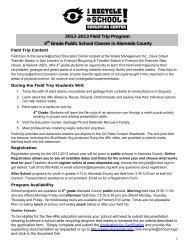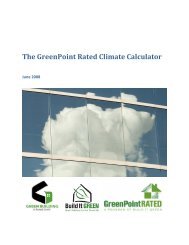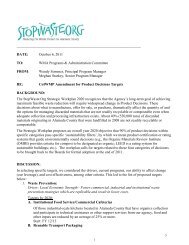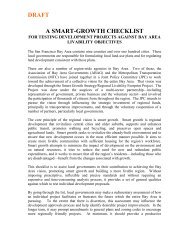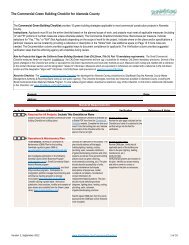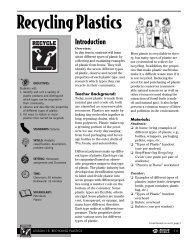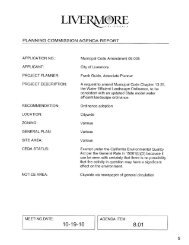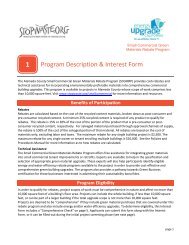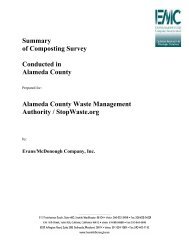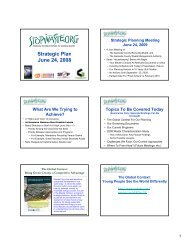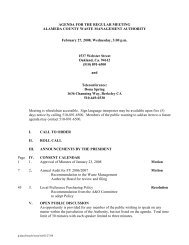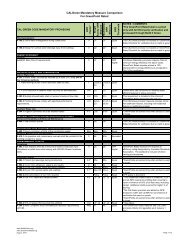Greener Options for Fiber Glass & Cellulose ... - StopWaste.org
Greener Options for Fiber Glass & Cellulose ... - StopWaste.org
Greener Options for Fiber Glass & Cellulose ... - StopWaste.org
- No tags were found...
You also want an ePaper? Increase the reach of your titles
YUMPU automatically turns print PDFs into web optimized ePapers that Google loves.
2012 Edition<strong>Greener</strong> <strong>Options</strong> <strong>for</strong><strong>Fiber</strong> <strong>Glass</strong> & <strong>Cellulose</strong> InsulationNatural <strong>Fiber</strong> Blown-In <strong>Cellulose</strong> Insulation. Photo courtesy Green<strong>Fiber</strong>.Unfaced <strong>Fiber</strong> <strong>Glass</strong> Roll Insulation. Photo courtesy Johns Manville.This brochure highlights environmentally preferablefiber glass and cellulose insulation products<strong>for</strong> use in residential building energy upgrades and retrofits.What Makes These Products Green?The building insulation products listed here are certified through third-party testing to:▪ Emit undetectable or ultra-low amounts of volatile <strong>org</strong>anic compounds (VOCs) including<strong>for</strong>maldehyde*▪ Have at least 30% post-consumer recycled contentOther chemicals of concern may be present in insulation. New screening criteria may be added to thisbrochure when appropriate hazard evaluation standards are identified.*Con<strong>for</strong>ms to Cali<strong>for</strong>nia Department of Public Health, Environmental Health Laboratory Branch, Standard Method <strong>for</strong> the Testing &Evaluation of VOC Emissions, V1.1, 2010 (CA Specification 01350) using the single family residence scenario found in Appendix B.View online at www.cal-iaq.<strong>org</strong>.
Benefits of Insulation withUltra-Low VOCs and Recycled ContentImproving Indoor Air QualityEach year, insulation is added to thousands of Cali<strong>for</strong>niahomes to make them more com<strong>for</strong>table and energyefficient. <strong>Fiber</strong> glass and cellulose insulation arecommonly used to insulate residential buildings. Whenchoosing these products, it’s important to consider not justenergy efficiency but also how the product will affect thehome’s indoor air quality.Insulation materials occupy a large volume of space insidea home’s walls, floors, and attic or roof area. Someinsulation products emit harmful chemical vapors such as<strong>for</strong>maldehyde. When the air pressure changes betweenthe inside and outside of buildings, airborne chemicalsemitted from insulation can move through walls, floors andceilings and pass into the home—a process known asinfiltration.The fiber glass and cellulose batts and blown-in insulationproducts listed on the next page as ultra-low VOC aresafer choices. They emit ultra-low or undetectable levels ofharmful chemicals, which helps keep indoor air healthierand may help prevent diseases like asthma and cancer.Promoting Recycling & Recycled-Content ProductsChoosing products with high post-consumer recycledcontent is good <strong>for</strong> the environment and the economy—itcreates markets <strong>for</strong> discarded materials like glass bottlesand newspapers and keeps them out of landfills. What’smore, recycled products typically require less energy tomanufacture than similar non-recycled products. Theinsulation products listed as recycled in this brochurecontain at least 30% post-consumer recycled content.Some contain over 80% post-consumer recycled content.Unfaced Batts. Photo courtesy Knauf Insulation.Unfaced Batts. Photo courtesy CertainTeed Saint-Gobain.About this BrochureSince 2010, <strong>StopWaste</strong>.Org has engaged withinsulation manufacturers to provide independentthird-party certification of the VOC emissions andrecycled content of fiber glass and celluloseinsulation products. In this 2012 update, these thirdpartycertifications have been verified by HealthyBuilding Network’s Pharos Project. More completeenvironmental in<strong>for</strong>mation <strong>for</strong> each product can befound at www.pharosproject.net.This brochure is a publication of Energy UpgradeCali<strong>for</strong>nia in Alameda County with input andsupport from U.S. EPA Region 9. Theenvironmental criteria used to screen the productslisted here may be modified, as warranted.Future updates will include newly certified products.Manufacturers interested in having their productslisted in this brochure can email Wes Sullens(WSullens@<strong>StopWaste</strong>.Org).PROPINK® L77 Loosefill <strong>Fiber</strong> <strong>Glass</strong> Insulation. Photo courtesy Owens Corning.<strong>Greener</strong> <strong>Options</strong> <strong>for</strong> <strong>Fiber</strong> <strong>Glass</strong> and <strong>Cellulose</strong> Insulation | May 2012www.<strong>StopWaste</strong>.Org/Insulation
<strong>Greener</strong> <strong>Options</strong> <strong>for</strong> <strong>Fiber</strong> <strong>Glass</strong>& <strong>Cellulose</strong> InsulationStop waste! For a handy reference, print only this page.Download the full brochure at www.<strong>StopWaste</strong>.Org/InsulationTable 1. <strong>Fiber</strong> <strong>Glass</strong> & <strong>Cellulose</strong> Insulation – Ultra-Low VOC and RecycledProducts listed in this table are independently certified to have both ultra-low VOC emissions levels and at least 30%post-consumer recycled content.ManufacturerProduct TypeJohns Manvillefiber glass battsJohns Manvilleblown-in fiber glassKnauffiber glass battsKnaufblown-in fiber glassOwens Corningfiber glass battsOwens Corningblown-infiber glassProduct NameUnfaced and Faced (kraft, MR) Batts and Rolls, Com<strong>for</strong>tTherm ® Batts andRolls; Easy Fit ® Unfaced and Kraft-Faced BattsUltra-Low VOCAttic Protector ® , ClimatePro ® , Spider ® EcoBatt ® Thermal and Acoustical Insulation Ecofill Wx <strong>Glass</strong> Wool Blowing Insulation EcoTouch ® PINK FIBERGLAS ® Insulation with Pure <strong>Fiber</strong> Technology EcoTouch ® QuietZone PINK FIBERGLAS ® Insulation EcoTouch ® Insulation with Pure <strong>Fiber</strong> Technology PROPINK ® L77 Loosefill Insulation, PROPINK Complete Blown-in WallSystem using PROPINK ® L77 Loosefill Insulation, AttiCat ® Expanding Blown-In PINK FIBERGLAS Table 2. <strong>Fiber</strong> <strong>Glass</strong> & <strong>Cellulose</strong> Insulation – Ultra-Low VOC or RecycledProducts listed in this table are independently certified to have either ultra-low VOC emissions or at least 30%post-consumer recycled content.ManufacturerProduct TypeCertainTeedfiber glass battsCertainTeedblown-in fiber glassGreen<strong>Fiber</strong>blown-in celluloseProduct NameCertaPRO AcoustaTherm , Thermal Extended Flange, Thermal FoilFaced and Thermal FSK-25 Batts; DryRight <strong>Fiber</strong> <strong>Glass</strong> Insulation;EasyTouch Encapsulated <strong>Fiber</strong> <strong>Glass</strong> Insulation; <strong>Fiber</strong> <strong>Glass</strong> BuildingInsulation; High-Per<strong>for</strong>mance <strong>Fiber</strong> <strong>Glass</strong> Building Insulation;NoiseReducer Acoustical Ceiling, Sound Attenuation, and Sound ControlBatts; SoftTouch Duct Wrap; Sustainable Insulation Faced and UnfacedBattsInsulSafe ® SP, OPTIMA ® , True Com<strong>for</strong>t , UltraCom<strong>for</strong>t Natural <strong>Fiber</strong> InsulationUltra-Low VOC<strong>Greener</strong> <strong>Options</strong> <strong>for</strong> <strong>Fiber</strong> <strong>Glass</strong> and <strong>Cellulose</strong> Insulation | May 2012www.<strong>StopWaste</strong>.Org/Insulation



